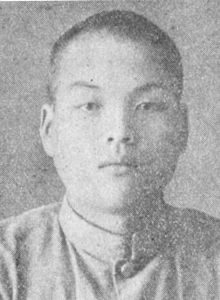Tsuyama massacre
| Tsuyama massacre | |
|---|---|

Mutsuo Toi, the 21-year-old responsible for the Tsuyama massacre
|
|
| Location | Kamo, Tsuyama, Okayama Prefecture, Empire of Japan |
| Date | 21 May 1938 1:30 a.m. – 3:00 a.m. |
| Target | Villagers |
|
Attack type
|
Mass murder, murder-suicide |
| Weapons | Remington M11 shotgun, Japanese sword, Axe |
| Deaths | 31 (including the perpetrator) |
|
Non-fatal injuries
|
3 |
| Perpetrator | Mutsuo Toi |
| Motive | Revenge |
The Tsuyama massacre (津山事件 Tsuyama jiken?) was a spree killing that occurred on 21 May 1938 in the rural village of Kamo close to Tsuyama city in Okayama, Japan.
Mutsuo Toi (都井 睦雄 Toi Mutsuo?), a 21-year-old man, killed 30 people, including his grandmother, with a Browning shotgun, Katana, and axe, and seriously injured three others before killing himself with the shotgun. Until the 1982 killing by Woo Bum-kon, this incident was regarded as the second-worst massacre by an individual in modern history, behind the 1927 killing of 44 people by Andrew Kehoe.
Mutsuo Toi cut the electricity line to the village of Kamo on the evening of 20 May, which left the community in darkness. At around 1:30 a.m. on 21 May, he killed his 76-year-old grandmother by decapitating her with an axe. Then he strapped two flashlights to his head and prowled through the village entering the homes of his neighbours. He killed 29 neighbours (27 of whom died at the scene of the incident, while two others were fatally wounded, dying of their injuries later) and seriously injured three others in about an hour and half using a Browning shotgun, a Japanese sword and an axe. This was almost half of the residents of the small community. At dawn he committed suicide by shooting himself in the chest.
...
Wikipedia
